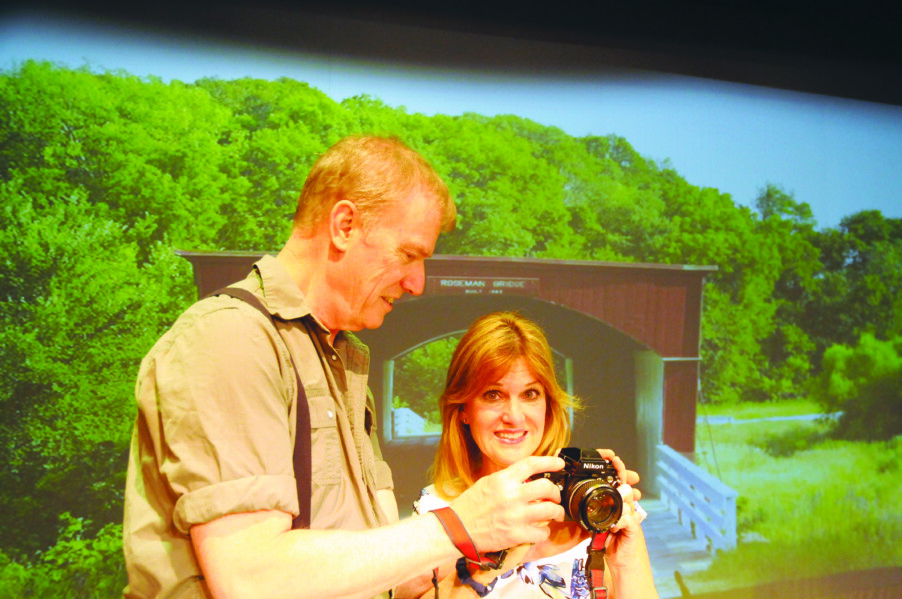ArtHub in Nashua opens on Main Street
By Michael Witthaus
Among the many hard-luck stories to come out of the pandemic, the story of Nashua Artists Association’s ArtHub Gallery stands out. NAAA opened it in February 2020, only to have the world shut it down a month later. The place remained a memory until now, but the rebirth is even better than the original.
To start with, the new location on Main Street has twice the room of the ill-fated Pearl Street space, and it’s in the heart of downtown. More room makes it easier to display larger objects, like the interesting work from sculptor George Eross, a T. Rex with duck feet and stubby arms made from dinner forks that serves as a de facto gallery mascot.
The addition of 3D art is a big part of ArtHub’s goal of including more artists.
“There is an amazing amount of talent in this area,” ArtHub co-manager Jacqueline Barry said in press release. “To bring that talent to our new downtown location will not only give the community the opportunity to see the local talent but inspire them to do their own work.”
A members-only quiet opening on May 8 also drew the curious, gallery co-manager Sonia Lee said recently, a marked difference from the light foot traffic at the old place.
“We had about 40 members come,” Lee said by phone. “And, there were two couples, not related to us, having dinner next door. They stopped in to see what we were doing.”
On May 14 the gallery will do a soft opening, followed by a grand reopening on Saturday, May 17. A wide range of work will be on display and available for purchase, from paintings and textile arts to ceramics made by artists like Nancy Barkman.
“One of the missions that we have is to give a place for the craftsmen, not just people who do wall art,” Lee said. “She’s a good example of that. Her work is artistic. You can say, well, it’s just a pot. Well, yeah. But it’s also artistic in that not just anybody can do that work. And there are a limited number of places where people who are craftsmen can show their work other than arts and crafts shows.”
Other artists displayed in the spring opening include Steve Goldstein, a Massachusetts photographer who works in black and white. Goldstein said, “creative image … serves as an antidote to all the screen time I encountered in my career as an electrical engineer.” Teresa Moller’s paintings are both colorful and whimsical. The Nashua artist will also present a puppet show during the grand opening.
Brenda Noiseux is a Granite State artist “encouraging conversations through artistic activism” who’s exhibited around the country including in Chicago and New York City, Kansas and Oregon. One of her pieces is a delicate heart-shaped bouquet surrounding the words, “Asylum was granted.” Another shows a faded student visa with “REVOKED” stamped on it, laid under a spray of flowers. Both are part of a series called “Awaiting Justice.”
The downtown gallery sits in what was formerly the League of New Hampshire Craftsmen’s gallery. Its centrality allows NAAA to take part in citywide efforts in a way they couldn’t previously, like the annual Holiday Stroll. “If you’re way off the main street, people aren’t going to come that way when you do the downtown events,” Lee said.
For nearly 75 years, the NAAA has served to advance art in Nashua and its surrounding communities. Their membership is composed of visual artists working in a variety of media as well as patrons of the arts. The organization welcomes all levels of experience, from students to established artists.
A few years after the organization formed, it launched Art in the Park, an effort that continues to this day. Through these combined efforts, they aim to foster collaborative efforts, Lee said. “Part of what I’m doing is reaching out to those other groups and recruiting, if for no other reason than just passing the word around. Because our mission is to encourage the arts, and it isn’t just our members that we’re talking about.”
Nashua Area Artists Association’s ArtHub Gallery – Grand Reopening
When: Saturdays, May 17, 2-7 p.m. with reception 5-7 p.m.
Where: 98 Main St., Nashua
More: On Facebook, search for “ArtHub – Downtown Gallery, Nashua Area Artists Association”
Featured photo: Work by George Eross & Work by Brenda Noiseux. Courtesy photo.





